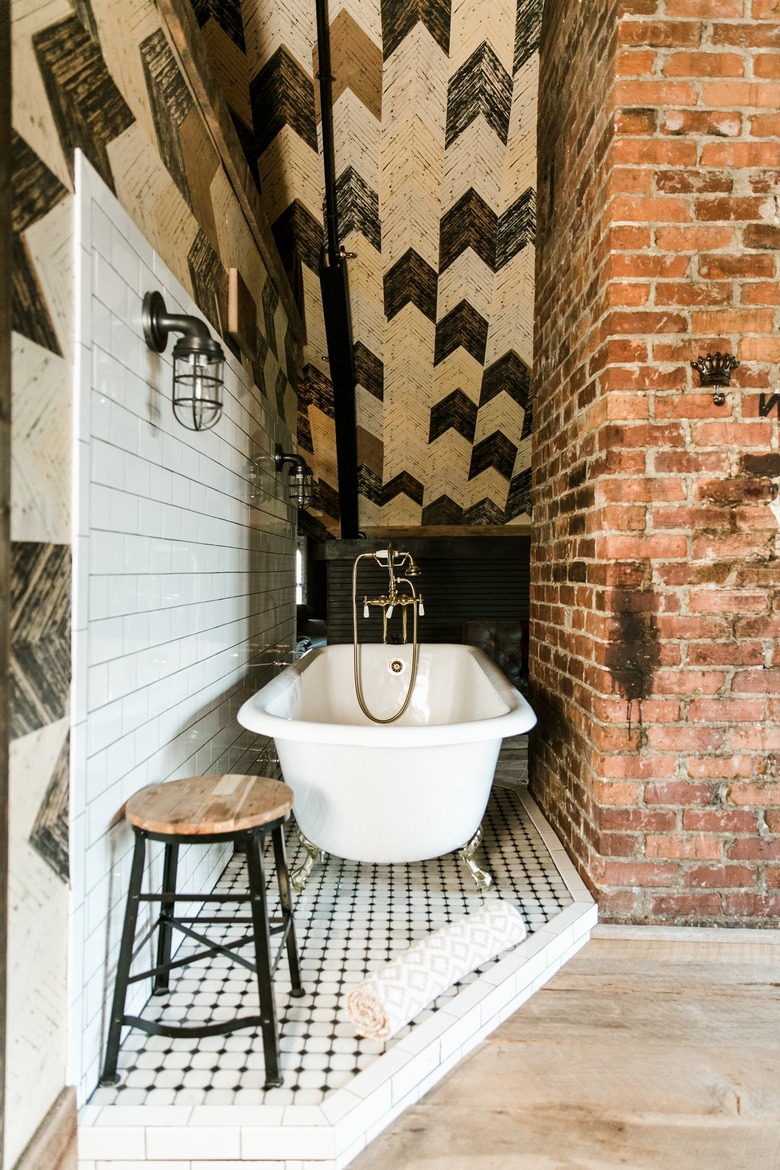A DIY Guide To Bathtub Repair
If you find a ding or a crack in your bathtub, don't panic. Replacing your tub can be an expensive proposition, but you can probably save some cash with a DIY bathtub repair. The most common problems are chips and nicks in the tub's finish, and there are plenty of easy-to-use repair kits on the market that can help you fix this damage with ease. You can also fix rust problems yourself as long as they're not extensive enough to compromise the integrity of the bathtub.
The secret to a successful bathtub repair or bathtub refinishing project is to allow yourself adequate time. Although the actual repair usually doesn't take long, many bathtub fixes involve epoxies applied in several thin layers. You'll need to allow adequate drying time between these layers, so don't plan on using your tub the same day that you repair it. Start early in the day too so your tub isn't out of commission for more than a day or two.
Repair Cracks in Fiberglass and Acrylic Bathtub
Repair Cracks in Fiberglass and Acrylic Bathtub
Although constructed slightly differently, both acrylic and fiberglass tubs have a top coat made of gel that seals and protects them. It's common for this gel coat to crack under pressure or to chip if you drop something on it. Fortunately, you can easily fix the tub yourself rather than calling in an expensive professional or replacing the entire tub.
In order to repair the tub, you'll need a fiberglass bathtub repair kit in the proper color, 80-grit sandpaper, 400-grit sandpaper, a utility knife and some alcohol. Your repair will involve the following steps:
Warning
The epoxy used to repair fiberglass often has a potent odor, so turn on your bathroom's ventilation fan and open a window before you start working. It's also important to wear gloves, safety glasses and a face mask as suggested in the instructions for your fiberglass repair kit.
- Sand the area around the chip or crack with 80-grit sandpaper. The pros at Terry's Plumbing suggest sanding about 1 inch beyond the damage.
- Wipe away any sanding dust and clean the area thoroughly with some alcohol or acetone nail polish remover. Let the area dry completely.
- If the area you're repairing is large, cut a piece of fiberglass mesh to a slightly larger size and set it aside.
- Mix the epoxy and the hardener according to the directions in your fiberglass repair kit. Typically, this involves mixing about half of the epoxy with four or five drops of hardener, but this ratio can vary from one repair kit to another. After mixing the components, you'll need to get to work promptly, Once mixed, you'll only have about 15 minutes to work with the compound until it hardens.
- Spread the compound as smoothly as you can over the hole or crack. Be sure to apply enough pressure that the repair compound is forced into the crack or hole and fills it completely.
- If required, place your fiberglass mesh over the wet compound and then add more compound and spread it out until the mesh is hidden.
- Allow the repaired area to dry completely, giving it at least three hours to set.
- Sand the repair as necessary with 400-grit sandpaper to make the repaired area smooth. If your repair kit came with sandpaper, use that instead.
- Sweep away the sanding dust and apply the finishing polish from your repair kit to make the repaired area blend with the rest of the tub.
Fix Chips in an Enameled Steel and Cast Iron Bathtub
Fix Chips in an Enameled Steel and Cast Iron Bathtub
Steel and cast iron tubs are definitely sturdier than those made from acrylic and fiberglass, but they too can need a little TLC on occasion. These tubs are also enshrined in a protective coating, but they're coated in enamel or porcelain rather than a gel coat. Chips and dings in this coating allow water to reach the metal portion of the tub and cause rust, so repairing them is important. If it's too late to prevent small rust spots, you can repair them using this method as well.
To do so, you'll need a ceramic or enamel bathtub repair kit. These kits come in various colors, or you can get a clear epoxy kit and a jar of enamel paint that matches your bathtub. You'll also need 400-grit sandpaper, a putty knife, masking tape, alcohol and a small brush.
Warning
Before you repair your enameled steel or cast iron bathtub, wear safety equipment recommended by the repair kit manufacturer.
- Sand the area to be repaired and wipe away any sanding dust. Clean the area with alcohol.
- Apply masking tape around the area you're repairing.
- Mix the enamel repair epoxy according to the instructions in your kit. Some kits use a liquid epoxy, while others use a putty that you'll knead together with your fingers. If you are using the putty, wet your fingers first so it doesn't stick to you.
- Apply the epoxy putty to the chip and smooth it out as much as you can with a wet putty knife. If you're using a liquid epoxy, paint it on with a small brush or smooth it on with a dry putty knife. Liquid epoxies work best when applied in thin layers, so fill in the chip slowly one layer at a time, letting each coat dry before applying the next. When you apply the final layer, make it as smooth as possible.
- Remove the masking tape. If doing so disrupts your putty, smooth it out again with a wet finger.
- Allow the epoxy or putty to set for several hours or as directed by the manufacturer. Benjamin Franklin Plumbing recommends that you allow the repair to dry for at least 24 hours, but it may need more time.
- Sand the epoxy until it's smooth and blends with the rest of the tub. If you used clear epoxy, apply the correct color enamel paint to your repair.
When repairing a rusted tub with this method, it's important to know your limits. Small rust spots are an easy DIY fix, but tubs that are rusted through probably need professional help to make sure they don't leak. If you're sanding so much rust that you're considering just grabbing the belt sander to make quicker work of the job, it's probably another sign to go pro.
How to Remove the Tub Drain Flange
How to Remove the Tub Drain Flange
Repairing rust chips and dings in a bathtub may require an extra step depending on where the damage is located. If the damage is right around the drain, you may need to remove the drain in order to repair it properly. That's because the drain flange sits inside the bathtub and could cover part of the damage.
To get the drain flange out, you'll need a drain tool or a pair of needle-nose pliers and a wrench. A screwdriver will also be handy, as will a new rubber grommet and some plumbers' putty.
- Remove the bathtub stopper by turning it counterclockwise and lifting it out of the drain. Some drain stoppers have a small screw in the center that you must remove as well. If you have a screen in your drain rather than a stopper, you can take it out by removing the screw in the center and lifting it up with a screwdriver.
- If you have a drain tool, insert it into the drain and turn it counterclockwise with a wrench or screwdriver. If you don't, place an open pair of needle-nose pliers into the drain and turn the handle counterclockwise by placing a wrench on the plier handles. Once loosened, the drain flange will simply lift out.
- Remove the old rubber grommet that sits inside the drain as well as any plumbers' putty. You'll replace these when you reinstall the drain.
- When your repairs are finished, evaluate your old drain. You can reinstall it if it's in good shape, but you should replace it if it's rusty or corroded.
- When reinstalling the drain, place a new rubber grommet in the drain.
- Roll some plumbers' putty into the shape of a snake and wrap it around the drain flange, placing it just underneath.
- Screw the drain flange back into place.
General Bathtub Repair Tips
General Bathtub Repair Tips
Bathtub repairs aren't difficult, but there are a few things to keep in mind that can make the job a bit easier. The first is to note where you're making your repair. Some epoxy repair kits work fine on the bottom of the tub but disappoint when used on vertical surfaces. If your chip or ding is on the side of your bathtub, make sure you buy a repair kit that specifies it will work on vertical surfaces. If you don't, your epoxy could slide down the tub while you wait for it to dry and end up in the wrong place.
When looking for a repair kit, contact your tub manufacturer first. Some sell repair kits specifically made to match the tub colors sold. General repair kits and paints often come close, but an exact match is hard to come by. If you can, get a kit from the bathtub maker for a more discreet repair. You can also experiment with different tints and colors until you get a match you like for your tub; even the pros use a bit of trial and error when looking for the best color match.
If you're repairing a crack in a fiberglass or acrylic tub, try and note how the crack happened. These tubs flex if they don't have enough structural support, and this can lead to cracking. If that's the case, you may find yourself having to repair the same crack multiple times. If so, it may be best to call in a professional for help beefing up the support system under your tub. It's a more extensive and expensive repair, but you'll only need to do it once.
References
- Terry's Plumbing: Repair A Cracked Bathtub
- Benjamin Franklin Plumbing: How to Fix A Chipped Sink or Bathtub
- HomeAdvisor: How to Repair Chips & Cracks in Your Bathtub or Shower Pan
- Terry's Plumbing: Repair A Peeling Tub
- YouTube: Someday I'll Learn – DIY Bathtub Repair
- Landmark Home Warranty: DIY: Fix a Rust Spot on Your Tub
- Sunrise Specialty: 6 Easy Steps to Remove a Bathtub Drain


